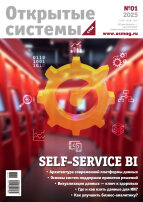_250x.jpg)
OS FORECAST
Technologies for life: OSJ Big Seven Forecasts, v. 2021
The Open Systems Journal.DBMS offers its seven technology development forecasts for 2021. The year 2020 was not the best time for technological breakthroughs, so traditional lists forecasts of the world's leading analysts for 2021 is largely the same as last year's.
Natalya Dubova (dubova@osp.ru), science editor, Open Systems Journal.DBMS (Moscow).
COVER FEATURE
6G
6G Vision: An AI-Driven Decentralized Network and Service Architecture
Recently, following the rapid commercial deployment of 5G networks, next-generation mobile communication technology (6G) has been attracting increasing attention from global researchers and engineers. 6G is envisioned as a distributed, decentralized, and intelligent innovative network. However, existing application provisioning is still based on a centralized service architecture, ubiquitous edge computing, and decentralized AI technologies have not been fully exploited. In this article, we analyze the problems faced by existing centralized service provisioning architecture, and propose design principles for a decentralized network and service architecture for a future 6G network. Finally, we discuss several open research problems to inspire readers to address these.
Xiuquan Qiao (qiaoxq@bupt.edu.cn), professor, Yakun Huang (hyk_it@foxmail.com), Ph.D. candidate, Junliang Chen (chjl@bupt.edu.cn), professor, Beijing University of Posts and Telecommunications; Schahram Dustdar (dustdar@dsg.tuwien.ac.at), professor, TU Wien, Austria.
6G Horizons
Technology-wise, the main feature of 6G mobile networks would be an innovative way of managing large data flows, rather than the increased link bandwidth itself. There is a need to change protocol stacks in order to switch from the client-server architecture to a peer-to-peer, as well as develop decentralized storage technologies. And still, that would not be enough.
Valery Korzhov (cwzerro@gmail.com), independent expert (Moscow).
SECURITY
Built-In Cybersecurity: Insights Into Product Security for Cyberphysical Systems at a Large Company
Security flaws in cyberphysical systems are expensive. The key to creating secure but affordable industrial cybersystems is to understand the various points at which security can be implemented to build security into a product. This article is written from the perspective of a practitioner and addresses several components of product security that work together to build security into cyberphysical systems.
Kenneth G. Crowther (kenneth.crowther@ge.com), product security leader, GE Global Research; Brian Rust (brian.rust@ge.com), senior manager for cybersecurity programs, General Electric.
Messengers and Security
With instant messaging systems being at the peak of their popularity, their security issues are yet to be addressed. Specifically, the problem of securing private communication over messengers is far from being resolved.
Dmitry Bogdanov (bogdanovds@rambler.ru), assistant professor, MEPhI; Vladislav Nozdrunov (nozdrunov_vi@tc26.ru), expert, Cryptographic Data Protection Standards Technology Committee (TK 26) (Moscow).
DATA MANAGEMENT
Ontologies: From Text to Facts
Just recently, there had been high hopes that deep learning would enable understanding the sense of text, although later it has become clear that practical solutions would need ontologies — structured knowledge models.
Sergey Gorshkov (serge@trinidata.ru), Konstantin Kondratiev (kondratiev@trinidata.ru), Roman Shebalov (shebalov@trinidata.ru), experts, TriniData (Yekaterinburg).
Continuous Business Intelligence: Monetizing Your Data
The majority of business intelligence solution deployment projects fail. In order for such solutions to become a part of business leader's day-to-day work, a continuous BI process should be established, not unlike continuous manufacturing.
Roman Rayevsky (romanraevsky@gmail.com), independent expert (Moscow).
IT MANAGEMENT
The Power is in the Details: When CMDB is Not Enough
If the connection between two datacenters is lost and it is unknown where exactly the cable runs, smart monitoring systems would be of no use. It is not enough for an IT department to have a configuration management database: IT asset management tools are also a must.
Sergey Dovgan (sergey.dovgan@sdisoft.ru), CTO, SDI Soft (Moscow).
OS MEETING ROOM
Bridging Russian Software and Hardware: Mission Possible?
Achieving real import substitution requires much effort: the challenge has turned out much harder than it was initially thought. Only systemic work could change the current import substitution situation, which hardly could be called satisfactory.
Nikolai Smirnov (nsmirnov@osp.ru), CIO.ru editor-in-chief (Moscow).
The Fight for Talent: The Digital Footprint of a High School Graduate
Almost every Russian family faces the issue of a son or daughter entering a university, sooner or later. How to make the right choice, and what universities could do to help high-school graduates place their bets? The digital footprint of a high school student, analyzed using big data techniques, would tell about the student's interests, helping to choose a future profession and potentially get higher-quality education.
Nikolai Smirnov (nsmirnov@osp.ru), CIO.ru editor-in-chief (Moscow).
OS MUSEUM
Conspiracy Theories Around Soviet Computer Origins
The history of the first Soviet computer is rather dramatic, and even has something of its own conspiracy theories. Specifically, it is still unknown what exactly inspired Russian computing machinery pioneers to begin creating the country's first computers. There is a possibility that aside from government support, a series of seemingly accidental events played a role, with those events helping to see the big picture of what actually happened.
Sergei Prokhorov (sergei.prokhorov@gmail.com), chief researcher, S.I.Vavilov Institute for the History of Science and Technology of the Russian Academy of Sciences; Dmitry Volkov (vlk@keldysh.ru), senior fellow, Keldysh Institute of Applied Mathematics of the Russian Academy of Sciences (Moscow).
LIBRARY
Horizons of Industrial Blockchain and Governmental AI
The September, October, and November Issues of Computer Magazine (IEEE Computer Society, Vol. 53, No. 9–11, 2020) cover blockchain and cyberphysical systems integration, the use of AI in public institutions, and various issues related to AI algorithms.
Alexander Tyrenko (shoorah@osp.ru), reviewer, Computerworld Russia (Moscow).
